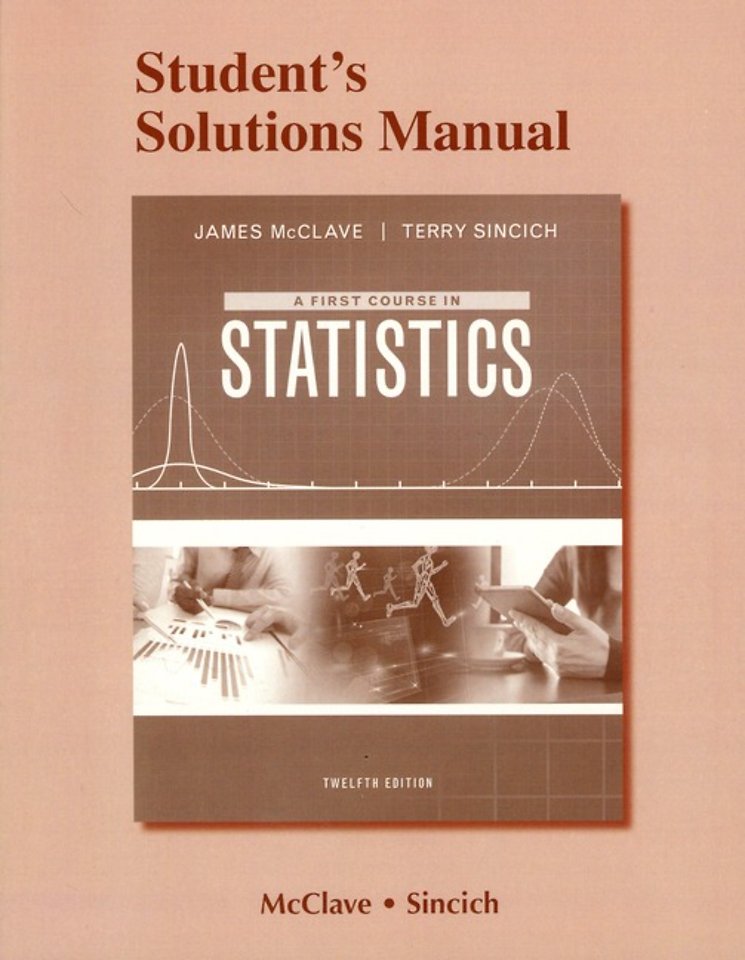James T. McClave,
Terry Sincich,
Terry T Sincich
Pearson Education
e druk, 2018
9780134081014
Student Solutions Manual for First Course in Statistics, A
Specificaties
Paperback, blz.
|
Engels
Pearson Education |
e druk, 2018
ISBN13: 9780134081014
Rubricering
Verwachte levertijd ongeveer 8 werkdagen
Samenvatting
This manual contains completely worked-out solutions for all the odd numbered exercises in the text.
Specificaties
Inhoudsopgave
<h2>Table of Contents</h2> <div class="c-non-traditional-number-list_container"> <ol> <li><strong>Statistics, Data, and Statistical Thinking</strong> <ul> <li>1.1 The Science of Statistics</li> <li>1.2 Types of Statistical Applications</li> <li>1.3 Fundamental Elements of Statistics</li> <li>1.4 Types of Data</li> <li>1.5 Collecting Data: Sampling and Related Issues</li> <li>1.6 The Role of Statistics in Critical Thinking and Ethics <ul> <li>Statistics in Action: Social Media Network Usage-Are You Linked In?</li> <li>Using Technology: MINITAB: Accessing and Listing Data</li> </ul></li> </ul></li> <li><strong>Methods for Describing Sets of Data</strong> <ul> <li>2.1 Describing Qualitative Data</li> <li>2.2 Graphical Methods for Describing Quantitative Data</li> <li>2.3 Numerical Measures of Central Tendency</li> <li>2.4 Numerical Measures of Variability</li> <li>2.5 Using the Mean and Standard Deviation to Describe Data</li> <li>2.6 Numerical Measures of Relative Standing</li> <li>2.7 Methods for Detecting Outliers: Box Plots and z-Scores</li> <li>2.8 Graphing Bivariate Relationships (Optional)</li> <li>2.9 Distorting the Truth with Descriptive Statistics <ul> <li>Statistics in Action: Body Image Dissatisfaction: Real or Imagined?</li> <li>Using Technology: MINITAB: Describing Data</li> <li>TI-83/TI—84 Plus Graphing Calculator: Describing Data</li> </ul></li> </ul></li> <li><strong>Probability</strong> <ul> <li>3.1 Events, Sample Spaces, and Probability</li> <li>3.2 Unions and Intersections</li> <li>3.3 Complementary Events</li> <li>3.4 The Additive Rule and Mutually Exclusive Events</li> <li>3.5 Conditional Probability</li> <li>3.6 The Multiplicative Rule and Independent Events <ul> <li>Statistics in Action: Lotto Buster! Can You Improve Your Chance of Winning?</li> <li>Using Technology: TI-83/TI-84 Plus Graphing Calculator: Combinations and Permutations</li> </ul></li> </ul></li> <li><strong>Random Variables and Probability Distributions</strong> <ul> <li>4.1 Two Types of Random Variables</li> <li>4.2 Probability Distributions for Discrete Random Variables</li> <li>4.3 The Binomial Random Variable</li> <li>4.4 Probability Distributions for Continuous Random Variables</li> <li>4.5 The Normal Distribution</li> <li>4.6 Descriptive Methods for Assessing Normality</li> <li>4.7 Approximating a Binomial Distribution with a Normal Distribution (Optional)</li> <li>4.8 Sampling Distributions</li> <li>4.9 The Sampling Distribution of x and the Central Limit Theorem <ul> <li>Statistics in Action: Super Weapons Development — Is the Hit Ratio Optimized?</li> <li>Using Technology: MINITAB: Discrete Probabilities</li> </ul></li> </ul></li> <li><strong>Inferences Based on a Single Sample</strong> <ul> <li>5.1 Identifying and Estimating the Target Parameter</li> <li>5.2 Confidence Interval for a Population Mean: Normal (z) Statistic</li> <li>5.3 Confidence Interval for a Population Mean: Student’s t-Statistic</li> <li>5.4 Large-Sample Confidence Interval for a Population Proportion</li> <li>5.5 Determining the Sample Size</li> <li>5.6 Confidence Interval for a Population Variance (Optional) <ul> <li>Statistics in Action: Medicare Fraud Investigations</li> <li>Using Technology: MINITAB: Confidence Intervals</li> </ul></li> </ul></li> <li><strong>Inferences Based on a Single Sample</strong> <ul> <li>6.1 The Elements of a Test of Hypothesis</li> <li>6.2 Formulating Hypotheses and Setting Up the Rejection Region</li> <li>6.3 Observed Significance Levels: p-values</li> <li>6.4 Test of Hypothesis about a Population Mean: Normal (z) Statistic</li> <li>6.5 Test of Hypothesis about a Population Mean: Student’s t-Statistic</li> <li>6.6 Large-Sample Test of Hypothesis about a Population Proportion</li> <li>6.7 Test of Hypothesis about a Population Variance (Optional)</li> <li>6.8 A Nonparametric Test about a Population Median (Optional) <ul> <li>Statistics in Action: Diary of a KLEENEX User How Many Tissues in a Box?</li> <li>Using Technology: MINITAB: Tests of Hypotheses</li> <li>TI-83/TI-84 Plus Graphing Calculator: Tests of Hypotheses</li> </ul></li> </ul></li> <li><strong>Comparing Population Means</strong> <ul> <li>7.1 Identifying the Target Parameter</li> <li>7.2 Comparing Two Population Means: Independent Sampling</li> <li>7.3 Comparing Two Population Means: Paired Difference Experiments</li> <li>7.4 Determining the Sample Size</li> <li>7.5 A Nonparametric Test for Comparing Two Populations: Independent Samples</li> <li>7.6 A Nonparametric Test for Comparing Two Populations: Paired Difference Experiment (Optional)</li> <li>7.7 Comparing Three or More Population Means: Analysis of Variance (Optional) <ul> <li>Statistics in Action: Zixlt Corp. vs. Visa USA Inc. — A Libel Case</li> <li>Using Technology: MINITAB: Comparing Means</li> <li>TI-83/TI-84 Plus Graphing Calculator: Comparing Means</li> </ul></li> </ul></li> <li><strong>Comparing Population Proportions</strong> <ul> <li>8.1 Comparing Two Population Proportions: Independent Sampling</li> <li>8.2 Determining Sample Size</li> <li>8.3 Testing Category Probabilities: Multinomial Experiment</li> <li>8.4 Testing Categorical Probabilities: Two-Way (Contingency) Table</li> </ul></li> <li><strong>Simple Linear Regression</strong> <ul> <li>9.1 Probabilistic Models</li> <li>9.2 Fitting the Model: The Least Squares Approach</li> <li>9.3 Model Assumptions</li> <li>9.4 Assessing the Utility of the Model: Making Inferences about the Slope β1</li> <li>9.5 The Coefficients of Correlation and Determination</li> <li>9.6 Using the Model for Estimation and Prediction</li> <li>9.7 A Complete Example</li> <li>9.8 A Nonparametric Test for Correlation (Optional) <ul> <li>Statistics in Action: Can “Dowsers” Really Detect Water?</li> <li>Using Technology: MINITAB: Simple Linear Regression</li> <li>TI-83/TI-84 Plus Graphing Calculator: Simple Linear Regression</li> </ul></li> </ul></li> </ol> <h3>Appendices</h3> <h4 class="h5">Short Answers to Selected Odd-Numbered Exercises</h4> <h4 class="h5">Index</h4> <h4 class="h5">Photo Credits</h4> </div>

